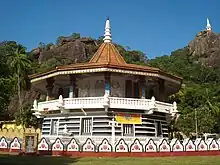Archaeological Protected Monuments in Sri Lanka
The archaeological heritage of Sri Lanka can be divided into three ages; Prehistoric (Stone-age), Protohistoric (Iron age), and historical period. The presence of man activities in Sri Lanka probably dates from 75,000 years ago (late Pleistocene period). Prehistoric sites which are presently identified in the country are distributed from the maritime belt and the lowland plains of the wet and dry zones to the high plateaus and rain forests in the central and southwestern mountain regions of the island. The protohistoric period expands from about 1000 BC to the historical period at about 500 BC. The main indicators of the distribution of protohistoric and early settlements on the island are the megalithic burials and pottery sites.
The beginning of the historical period of Sri Lanka is traditionally assigned to the reign of King Devanampiya Tissa (307–267 BC) when the Buddhism was introduced to Sri Lanka by the missionaries sent by the Indian emperor Ashoka. However, the first clear information about the establishment of buildings and structures are dated back to the time of king Pandukabhaya (437–367 BC).
Sri Lanka's political and religious history is mainly set out by the ancient chronicles as well as over 4,000 stone inscriptions from the 3rd century BC onward. Which gives the history in considerable detail from the 3rd century and less reliably back to the 6th century BC.
Sri Lanka has more than 250,000 identified archaeological sites throughout the country[1] and some of them have been declared as archaeological reserves and protected monuments by the Sri Lanka archaeological department. Archaeological reserves are sites that consist of archaeological remains which are under the direct control of the archaeological department. Protected monuments are privately owned but scheduled under section 18 of the Antiquities Ordinance No.09 of 1940.
Declaration of monuments
According to sections 16, 17, 18, and 19 of the Antiquities Ordinance No.09 of 1940, the minister who is in charge of the subject may declare the ancient monuments by notification published in the government Gazette.[2] Also under sections 16, 17, and 19, ancient buildings and trees on state or private lands, may be declared as ancient monuments to provide safety and protection for them.
Ancient construction with a historical and archaeological value which are over 100 years of age can also be declared as ancient monuments in terms of the provisions of the Antiquities (Amendment) Act No. 24 of 1988.
Central Province
Kandy District
Matale District
Nuwara Eliya District
Eastern Province
Ampara District
Batticaloa District
| Monument | Image | Location | Grama Niladhari Division |
Divisional Secretary's Division |
Registered | Description | Refs |
|---|---|---|---|---|---|---|---|
| Batticaloa fort | _fort.jpg.webp) | Batticaloa Town | Batticaloa | [3] | |||
| Pulukunawa Raja Maha Vihara | Eruwilporativu | Manmunai Pattu | The Drip-ledged caves, Dagobas, pillared structures, Asanagharas, ponds and a torso of a Buddha image | [4] | |||
Trincomalee District
North Central Province
Anuradhapura District
Polonnaruwa District
| Monument | Image | Location | Grama Niladhari Division |
Divisional Secretary's Division |
Registered | Description | Refs |
|---|---|---|---|---|---|---|---|
| Dimbulagala Raja Maha Vihara |  | Dimbulagala | 211-Dimbulagala | Dimbulagala | 24 May 1957 | [5] | |
| Halmillawewa Ruins | Halmillawewa | 32-Gal Oya | Hingurakgoda | 23 February 2007 | Ancient Dagaba and ruins of buildings situated in the forest area close to Halmillawewa | [6] | |
| Kaudagala Forest Monastery | Kurulubedda | 282-Mahindagama | Welikanda | 20 March 2017 | Ruins of ancient stupas,ruins of buildings,caves with drips and paintings situated in the forest area close to Kaudagala | [7] | |
| Medirigiriya Vatadage |  | Medirigiriya | 87-Medirigiriya | Medirigiriya | |||
| Nagalakanda Mahasen Monastery | Minneriya | ||||||
| Namal Pokuna Monastery | Dimbulagala | Dimbulagala | |||||
| Silumina Seya | Aralaganwila | ||||||
| Unagalawehera Rajamaha Viharaya |  | Unagalawehera | 52-Unagalavehera West | Hingurakgoda | |||
| Somawathiya Chaitya |  | Meenvillu | 137-Sungawila | Lankapura | 7 July 1967 | The Stupa | [8] |
North Western Province
Kurunegala District
Puttlam District
Northern Province
Jaffna District
Kilinochchi District
Mannar District
Mullaitivu District
Vavuniya District
Sabaragamuwa
Kegalle District
Ratnapura District
Southern Province
Galle District
Hambantota District
Matara District
Uva
Badulla District
Monaragala District
Western Province
Colombo District
Gampaha District
Kalutara District
References
- "History of the Department of Archeology". Sri Lanka archaeological department. Archived from the original on 2 December 2016. Retrieved 19 August 2017.
- "Exploration and Documentation Division#Declaring of Ancient Monuments". Sri Lanka archaeological department. Retrieved 19 August 2017.
- The Hansard report
- "Pulukunava". Department of Archaeology. Retrieved 18 July 2016.
- "Gazette". The Gazette of the Democratic Socialist Republic of Sri Lanka. 11119. 24 May 1957.
- Gazette 1486 & 23 February 2007, p. 12.
- "Kaudagala Forest Monastery" (PDF). Department of Archeological, Sri Lanka.
- "Gazette". The Gazette of the Democratic Socialist Republic of Sri Lanka. 14756. 7 July 1967.
Notes
- "PART I : SECTION (I) — GENERAL Government Notifications" (PDF). The Gazette of the Democratic Socialist Republic of Sri Lanka. 1486. 23 February 2007.